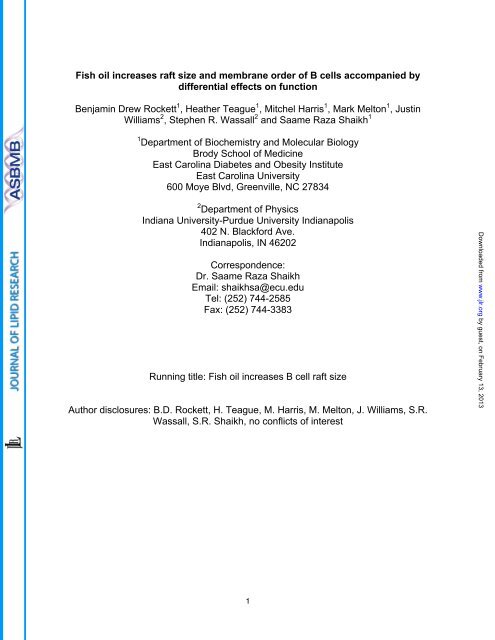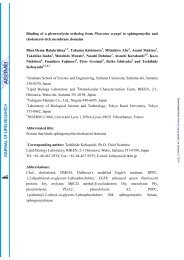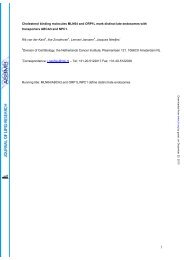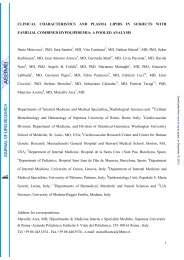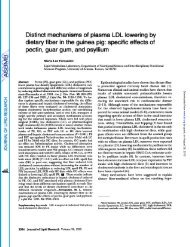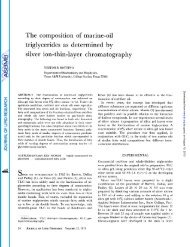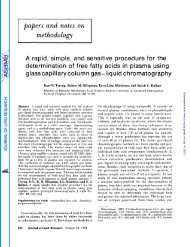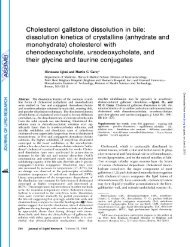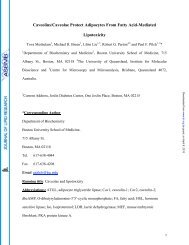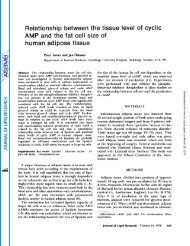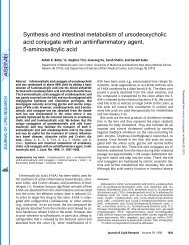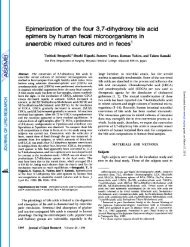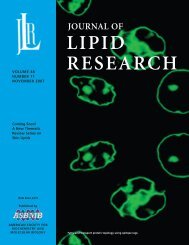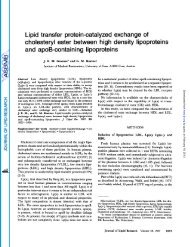Fish oil increases raft size and membrane order of B cells ...
Fish oil increases raft size and membrane order of B cells ...
Fish oil increases raft size and membrane order of B cells ...
- No tags were found...
You also want an ePaper? Increase the reach of your titles
YUMPU automatically turns print PDFs into web optimized ePapers that Google loves.
<strong>Fish</strong> <strong>oil</strong> <strong>increases</strong> <strong>raft</strong> <strong>size</strong> <strong>and</strong> <strong>membrane</strong> <strong>order</strong> <strong>of</strong> B <strong>cells</strong> accompanied by<br />
differential effects on function<br />
Benjamin Drew Rockett 1 , Heather Teague 1 , Mitchel Harris 1 , Mark Melton 1 , Justin<br />
Williams 2 , Stephen R. Wassall 2 <strong>and</strong> Saame Raza Shaikh 1<br />
1 Department <strong>of</strong> Biochemistry <strong>and</strong> Molecular Biology<br />
Brody School <strong>of</strong> Medicine<br />
East Carolina Diabetes <strong>and</strong> Obesity Institute<br />
East Carolina University<br />
600 Moye Blvd, Greenville, NC 27834<br />
2 Department <strong>of</strong> Physics<br />
Indiana University-Purdue University Indianapolis<br />
402 N. Blackford Ave.<br />
Indianapolis, IN 46202<br />
Correspondence:<br />
Dr. Saame Raza Shaikh<br />
Email: shaikhsa@ecu.edu<br />
Tel: (252) 744-2585<br />
Fax: (252) 744-3383<br />
Running title: <strong>Fish</strong> <strong>oil</strong> <strong>increases</strong> B cell <strong>raft</strong> <strong>size</strong><br />
Author disclosures: B.D. Rockett, H. Teague, M. Harris, M. Melton, J. Williams, S.R.<br />
Wassall, S.R. Shaikh, no conflicts <strong>of</strong> interest<br />
1<br />
Downloaded from<br />
www.jlr.org<br />
by guest, on February 13, 2013
ABSTRACT<br />
<strong>Fish</strong> <strong>oil</strong> (FO) targets lipid microdomain organization to suppress T cell <strong>and</strong> macrophage<br />
function; however, little is known about this relationship with B <strong>cells</strong>, especially at the<br />
animal level. We previously established a high FO dose diminished mouse B cell lipid<br />
<strong>raft</strong> microdomain clustering induced by cross-linking GM1. To establish relevance, here<br />
we tested a FO dose modeling human intake on B cell <strong>raft</strong> organization, relative to a<br />
control. Biochemical analysis revealed more DHA incorporated into<br />
phosphatidylcholines than phosphatidylethanolamines <strong>of</strong> detergent-resistant<br />
<strong>membrane</strong>s, consistent with supporting studies with model <strong>membrane</strong>s. Subsequent<br />
imaging experiments demonstrated FO increased <strong>raft</strong> <strong>size</strong>, GM1 expression, <strong>and</strong><br />
<strong>membrane</strong> <strong>order</strong> upon cross-linking GM1 relative to no cross-linking. Comparative in<br />
vitro studies showed some biochemical differences from in vivo measurements but<br />
overall revealed DHA, but not EPA, increased <strong>membrane</strong> <strong>order</strong>. Finally, we tested the<br />
hypothesis that disrupting <strong>raft</strong>s with FO would suppress B cell responses ex vivo.<br />
Surprisingly, FO enhanced LPS-induced B cell activation, yet suppressed B cell<br />
stimulation <strong>of</strong> transgenic naïve CD4 + T <strong>cells</strong>. Altogether, studies with B <strong>cells</strong> supported<br />
an emerging model that FO <strong>increases</strong> <strong>raft</strong> <strong>size</strong> <strong>and</strong> <strong>membrane</strong> <strong>order</strong> accompanied by<br />
functional changes; furthermore, the results highlighted differences in EPA <strong>and</strong> DHA<br />
bioactivity.<br />
Supplementary key words: antigen presenting cell, cytokines, detergent resistant<br />
<strong>membrane</strong>, docosahexaenoic acid, GM1, lymphocytes.<br />
2<br />
Downloaded from<br />
www.jlr.org<br />
by guest, on February 13, 2013
INTRODUCTION<br />
<strong>Fish</strong> <strong>oil</strong> (FO), enriched in n-3 polyunsaturated fatty acids (PUFAs), is increasingly<br />
hypothe<strong>size</strong>d to have beneficial health effects for treating symptoms for a wide range <strong>of</strong><br />
diseases associated with chronic inflammation (1-3). However, several hurdles have<br />
prevented the therapeutic use <strong>of</strong> FO in the clinic including a limited underst<strong>and</strong>ing <strong>of</strong> the<br />
molecular targets <strong>and</strong> mechanisms <strong>of</strong> n-3 PUFAs. The proposed mechanisms by which<br />
n-3 PUFAs <strong>of</strong> FO, eicosapentaenoic acid (EPA) <strong>and</strong> docosahexaenoic (DHA) acid,<br />
exert immunosuppressive effects are pleiotropic (4). These include incorporating into<br />
<strong>membrane</strong> phospholipids <strong>and</strong> modifying plasma <strong>membrane</strong> microdomain organization,<br />
serving as precursors for bioactive lipid molecules, disrupting intracellular signaling <strong>and</strong><br />
regulating gene expression (4). Recently, manipulation <strong>of</strong> lipid <strong>raft</strong> microdomains with n-<br />
3 PUFAs has gained attention since this mode <strong>of</strong> action is central to many <strong>of</strong> the<br />
downstream effects <strong>of</strong> n-3 PUFAs (5).<br />
Several models, not in complete agreement, have emerged to explain how n-3<br />
PUFAs disrupt <strong>raft</strong> molecular organization. One model, based on ex vivo studies <strong>of</strong> the<br />
CD4 + T cell immunological synapse, is that n-3 PUFAs, relative to controls, enhance the<br />
formation <strong>of</strong> more <strong>order</strong>ed <strong>and</strong> possibly larger lipid <strong>raft</strong>s upon stimulation <strong>of</strong> the cell (6).<br />
This model is the most relevant since it relied on the fat-1 transgenic mouse that has<br />
higher endogenous levels <strong>of</strong> n-3 PUFAs compared to control mice. A second model<br />
developed with studies in model <strong>membrane</strong>s, is that phosphatidylethanolamines<br />
containing DHA largely avoid <strong>raft</strong> molecules to form their own entities as non-<strong>raft</strong><br />
domains (7, 8). Finally, a more integrated model, based mostly on in vitro studies, is that<br />
n-3 PUFAs incorporate directly into <strong>raft</strong>s <strong>and</strong> in some cell types force cholesterol<br />
3<br />
Downloaded from<br />
www.jlr.org<br />
by guest, on February 13, 2013
molecules to undergo displacement between <strong>raft</strong>s <strong>and</strong> non-<strong>raft</strong>s (5, 9, 10). Overall, the<br />
majority <strong>of</strong> these models have not relied on physiologically relevant conditions that<br />
model human intake <strong>of</strong> FO.<br />
Based on studies with CD4 + T <strong>cells</strong>, macrophages, <strong>and</strong> splenocytes, disruption <strong>of</strong><br />
<strong>raft</strong>s with n-3 PUFAs generally suppresses cellular function (6, 11, 12). Far less is<br />
known about the relationship between disruption <strong>of</strong> lipid <strong>raft</strong>s with n-3 PUFAs <strong>and</strong><br />
downstream function in other cell types. In particular, B <strong>cells</strong> are increasingly<br />
recognized to have a role in inflammatory processes <strong>and</strong> autoimmune diseases (13,<br />
14); however, there is limited underst<strong>and</strong>ing about how FO impacts B cell <strong>membrane</strong><br />
organization <strong>and</strong> function, especially at the animal level. We previously demonstrated<br />
that feeding C57BL/6 mice a very high dose <strong>of</strong> n-3 PUFAs for 3 weeks diminished B cell<br />
lipid <strong>raft</strong> clustering (15). We also showed that mice consuming this very high dose for 14<br />
weeks displayed enhanced B cell activation, which we speculated was due to an<br />
increase in body weight gain (16). However, we did not completely test the effects <strong>of</strong> a<br />
physiologically relevant dose <strong>of</strong> FO on <strong>raft</strong> organization, the mode <strong>of</strong> <strong>raft</strong> disruption, or<br />
its relationship with innate <strong>and</strong> adaptive B cell function.<br />
The specific objectives <strong>of</strong> this study were to: 1) determine if administration <strong>of</strong> a<br />
dose <strong>of</strong> FO, modeling human intake, disrupted lipid <strong>raft</strong> organization <strong>of</strong> mouse B <strong>cells</strong>,<br />
2) address the conflicting models on how n-3 PUFAs disrupted <strong>raft</strong> molecular<br />
organization <strong>and</strong> 3) test the hypothesis that altering <strong>raft</strong> organization with FO would<br />
promote immunosuppressive effects on downstream innate <strong>and</strong> adaptive B cell function.<br />
The approach relied on biochemical <strong>and</strong> imaging measurements <strong>of</strong> B <strong>cells</strong> isolated from<br />
mice fed fish <strong>oil</strong>, supplemented with in vitro <strong>and</strong> model <strong>membrane</strong> studies. The data<br />
4<br />
Downloaded from<br />
www.jlr.org<br />
by guest, on February 13, 2013
evealed for the first time that a relevant dose <strong>of</strong> FO increased B cell <strong>raft</strong> <strong>size</strong> <strong>and</strong><br />
<strong>membrane</strong> molecular <strong>order</strong> upon cross-linking <strong>raft</strong>s, which was accompanied by novel<br />
downstream functional effects.<br />
5<br />
Downloaded from<br />
www.jlr.org<br />
by guest, on February 13, 2013
MATERIALS AND METHODS<br />
Mice <strong>and</strong> diets. Male C57BL/6 mice (Charles River), 4-6 weeks old, were fed for 3<br />
weeks either a purified control (CON) diet or a fish <strong>oil</strong> (FO) diet (Harlan-Teklad). Both<br />
diets consisted <strong>of</strong> 5% total fat by weight or 13% by total energy. All ingredients were<br />
essentially identical except the fat source, which was soybean <strong>oil</strong> in the CON diet <strong>and</strong><br />
menhaden fish <strong>oil</strong> in the FO diet (Table 1). The FO diet also contained food coloring,<br />
which we ensured had no effects on the measurements described below. The fatty acid<br />
distribution <strong>of</strong> the diet, measured with gas chromatography (GC), was within<br />
experimental error to that reported by the vendor (Harlan-Teklad) (Suppl. Table 1).<br />
Approximately 2% <strong>of</strong> the total kcal came from EPA <strong>and</strong> 1.3% from DHA. This level <strong>of</strong><br />
EPA/DHA corresponded to approximately 4 grams <strong>of</strong> FO consumed by a human on a<br />
daily basis, which can be achieved through the diet, <strong>and</strong> is currently in use<br />
pharmacologically for treating elevated triglycerides (17). Mice were sacrificed using<br />
CO2 inhalation <strong>and</strong> cervical dislocation followed by isolation <strong>of</strong> spleens. All <strong>of</strong> the<br />
experiments with mice fulfilled the guidelines established by the East Carolina<br />
University Brody School <strong>of</strong> Medicine for euthanasia <strong>and</strong> humane treatment.<br />
Cell isolation <strong>and</strong> cell culture. B220 + B <strong>cells</strong> (> 90% purity) were isolated from<br />
splenocytes by negative selection (Miltenyi Biotech) as previously described (16). For<br />
some experiments, CD4 + T <strong>cells</strong> (> 85% purity) were purified from B6.Cg-<br />
Tg(TcraTcrb)425Cbn/J mice (OT-II) (Jackson Laboratory) that express α- <strong>and</strong> β-chain T<br />
cell receptor <strong>and</strong> CD4 co-receptor specific for recognizing chicken ovalbumin 323-339<br />
6<br />
Downloaded from<br />
www.jlr.org<br />
by guest, on February 13, 2013
(OVA 323-339) presented by H-2 IAb molecules. For in vitro studies, mouse EL4<br />
lymphomas were treated with 25 µM EPA or DHA complexed to BSA for 15.5 hours as<br />
previously described (18). BSA without complexed fatty acid served as the control (18).<br />
Isolation <strong>of</strong> detergent resistant <strong>membrane</strong>s <strong>and</strong> analysis. 30x10 6 B <strong>cells</strong> or 20x10 6<br />
EL4 <strong>cells</strong> were prepared for detergent extraction <strong>and</strong> layered on a sucrose gradient as<br />
previously described (18). Sucrose gradients were centrifuged at 40,000 rpm for 20 h at<br />
4°C in a swinging bucket SW41Ti rotor (Beckman). Twelve 1 mL fractions were<br />
collected. Fractions 3-6 representing detergent resistant <strong>membrane</strong>s (DRMs), or 9-12<br />
representing detergent soluble <strong>membrane</strong>s (DSMs), were combined based on their<br />
cholesterol content, measured with an Amplex Red cholesterol assay kit (Invitrogen)<br />
relative to protein levels. Lipids were extracted as described previously (18). Samples<br />
were dissolved in chlor<strong>of</strong>orm <strong>and</strong> select phospholipids were separated with a Shimadzu<br />
Prominence HPLC using a 150 x 4.6 mm Luna 5 µm NH2 column (Phenomenex) with a<br />
mobile phase gradient <strong>of</strong> H2O (increasing from 5% to 50%) <strong>and</strong> acetonitrile (decreasing<br />
from 95% to 50%) at 30°C. Phosphatidylethanolamine (PE), phosphatidylcholine (PC),<br />
<strong>and</strong> sphingomyelin (SM) fractions were collected by UV detection at 202 nm <strong>and</strong> the<br />
acyl chain composition <strong>of</strong> each fraction was further analyzed by GC as previously<br />
shown (18). The rationale for selecting these phospholipids was to address the most<br />
abundant lipids <strong>of</strong> the outer (PC, SM) <strong>and</strong> inner (PE) leaflets <strong>and</strong> to allow direct<br />
comparison with other studies (19).<br />
7<br />
Downloaded from<br />
www.jlr.org<br />
by guest, on February 13, 2013
2 H NMR spectroscopy. Sample preparation, NMR spectroscopy, <strong>and</strong> analysis were as<br />
previously described (7). The PC phospholipid (1-[ 2 H31] palmitoyl-2-<br />
docosahexaenoylphosphatidylcholine,16:0-22:2PC-d31) used for this study was<br />
perdeuterated in the sn-1 chain (custom synthesis, Avanti Polar Lipids) <strong>and</strong> the samples<br />
consisted <strong>of</strong> aqueous multilamellar dispersions <strong>of</strong> 50 wt% lipid in 50 mM Tris buffer (pH<br />
7.5). Briefly, lipid mixtures <strong>of</strong> 16:0-22:6PC-d31/SM (1:1) <strong>and</strong> 16:0-22:6PC-<br />
d31/SM/cholesterol (1:1:1) were co-dissolved in chlor<strong>of</strong>orm. The solvent was removed,<br />
the lipids hydrated with buffer <strong>and</strong> pH adjusted. After 3 lyophilizations with deuterium-<br />
depleted water (Sigma), samples were transferred to a 5 mm NMR tube. Stringent<br />
precautions were taken to prevent oxidation during sample preparation <strong>and</strong> data<br />
acquisition. NMR experiments were performed on a homebuilt spectrometer operating<br />
at 7.05 T employing a phase alternated quadrupolar echo sequence (8, 20).<br />
Lipid <strong>raft</strong> cross-linking <strong>and</strong> TIRF imaging. Cells were fluorescently stained for lipid<br />
<strong>raft</strong>s by cross-linking cholera toxin subunit B-FITC (CTxB) (Invitrogen) <strong>and</strong> then imaged<br />
using total internal reflection fluorescence (TIRF) microscopy. For select experiments,<br />
GM1 levels were measured by staining with anti-CTxB with no secondary antibody for<br />
cross-linking. TIRF was performed on an Olympus IX-71 microscope with excitation at<br />
488 nm by a 20 mW Sapphire laser <strong>and</strong> a 60x 1.45NA <strong>oil</strong>-immersion TIRF objective.<br />
Fluorescence emission was filtered through a LF-488/561-A-OMF filter cube (Semrock)<br />
<strong>and</strong> detected by a Hamamatsu ORCA-R2 progressive scan interline CCD camera. For<br />
all imaging experiments, 9-10 <strong>cells</strong> per diet were analyzed per experiment <strong>and</strong> image<br />
analysis was performed as previously described (18).<br />
8<br />
Downloaded from<br />
www.jlr.org<br />
by guest, on February 13, 2013
Live cell imaging <strong>of</strong> DiIC18. To assess changes in non-<strong>raft</strong> organization, we measured<br />
uptake <strong>of</strong> the non-<strong>raft</strong> probe 1,1'-dioctadecyl-3,3,3',3'-tetramethylindocarbocyanine<br />
perchlorate (DiIC18, Invitrogen) (21). The approach was similar to our previous report<br />
where we used FAST-DiI (15); however, FAST-DiI uptake was extremely rapid under<br />
live cell imaging conditions; therefore, we relied on DiIC18. 1x10 6 B <strong>cells</strong> were washed<br />
with RPMI 1640 without phenol red at 37°C <strong>and</strong> resuspended in 1 mL <strong>of</strong> the same<br />
media <strong>and</strong> placed into Delta T dishes (Bioptechs Inc.). 0.2 µl <strong>of</strong> a 1 mg/mL stock <strong>of</strong><br />
DiIC18 was added to the dishes <strong>and</strong> imaged. Live cell widefield microscopy was<br />
conducted with an Olympus IX-70 microscope using an <strong>oil</strong> 100X objective <strong>and</strong> a<br />
Hamamatsu CCD camera, equipped with stage <strong>and</strong> objective heaters (Bioptechs Inc).<br />
Imaging was started at 1 minute after addition <strong>of</strong> the fluorescent probe at 37°C. Images<br />
were acquired with MetaMorph s<strong>of</strong>tware <strong>and</strong> analyzed with NIH ImageJ. All settings<br />
were kept constant between experiments.<br />
Generalized polarization imaging. Generalized polarization (GP) was calculated to<br />
determine the molecular <strong>order</strong> <strong>of</strong> the B <strong>and</strong> EL4 cell plasma <strong>membrane</strong> (22). Cells were<br />
stained with 4 µM di-4-ANEPPDHQ (Invitrogen) for 30 min at 37°C, washed twice with<br />
PBS, <strong>and</strong> fixed with 4% paraformaldehyde (23). For some experiments, as an additional<br />
control, B <strong>cells</strong> were treated with 10 µM methyl-β-cyclodextrin (mβCD) (Sigma-Aldrich)<br />
for 15 min at 37°C to deplete cholesterol. Imaging was conducted on a Zeiss LSM-510<br />
confocal microscope using a 100X objective with excitation at 488 nm <strong>and</strong> fluorescence<br />
emission detected in two channels, 505-545 nm for <strong>order</strong>ed regions, 650-750 nm for<br />
dis<strong>order</strong>ed regions. Quantification <strong>of</strong> fluorescence intensity (I), after background<br />
9<br />
Downloaded from<br />
www.jlr.org<br />
by guest, on February 13, 2013
subtraction for the two channels, was preformed using NIH ImageJ. GP was calculated<br />
using the formula: GP = (I505-545 - (G)I650-750)/(I505-545 + (G)I650-750), where G is the G-<br />
factor <strong>and</strong> I is fluorescence intensity (22).<br />
B cell activation with LPS. B <strong>cells</strong> were stimulated with 1 µg/mL <strong>of</strong> LPS for 24 hours<br />
<strong>and</strong> the secreted cytokine pr<strong>of</strong>iles were measured from supernatants using a Multi-<br />
Analyte ELISArray kit (SA Biosciences) as previously demonstrated (16). In addition, B<br />
<strong>cells</strong> were analyzed for surface expression <strong>of</strong> activation markers using fluorescently<br />
labeled anti-major histocompatibility complex II (MHC class II) M5/114.15 (Bio X Cell),<br />
anti-CD69 H1.2F3 (BD Biosciences), <strong>and</strong> anti-CD80 16-10A1 (Bio X Cell) on a BD LSR<br />
II flow cytometer. Antibodies for MHC class II <strong>and</strong> CD80 were conjugated with<br />
fluorophores using a kit (GE Healthcare).<br />
B cell activation <strong>of</strong> naïve CD4 + T <strong>cells</strong>. B <strong>cells</strong> were peptide loaded with OVA323-339<br />
(GenScript) at various concentrations in serum free media for 1 hour at 37°C <strong>and</strong> then<br />
washed with fresh media. 1x10 5 B <strong>cells</strong> were then plated with 3x10 5 non-diet modified<br />
OT-II transgenic T <strong>cells</strong>, spun quickly, <strong>and</strong> incubated for 24 hours at 37°C in 96 well<br />
plates. After 24 hours, the supernatant was collected to analyze secreted IFNγ <strong>and</strong> IL-2<br />
with an ELISArray kit (SA Biosciences) following the manufacturer's protocol. The <strong>cells</strong><br />
were stained with fluorescently labeled anti-CD4-PE (Miltenyi Biotech), anti-CD69-FITC<br />
(BD Biosciences), <strong>and</strong> anti-CD25-PE-Cy7 (BD Biosciences) <strong>and</strong> analyzed by flow<br />
cytometry on a BD LSR II. In all flow cytometry experiments, SYTOX Blue (Invitrogen)<br />
was used to discriminate dead <strong>cells</strong> <strong>and</strong> at least 10,000 live events were collected for<br />
10<br />
Downloaded from<br />
www.jlr.org<br />
by guest, on February 13, 2013
analyses. Control experiments were routinely conducted in the absence <strong>of</strong> peptide <strong>and</strong><br />
with T <strong>cells</strong> only (no B <strong>cells</strong>) to ensure T cell activation was driven by peptide loaded B<br />
<strong>cells</strong>.<br />
Statistical analyses. All ex vivo <strong>and</strong> in vitro data are from several independent<br />
experiments, with each ex vivo experiment representing one mouse per diet. The only<br />
exception was ex vivo DRM/DSM analysis in which 2 mice were pooled per experiment.<br />
Data were first analyzed for normality using a Kolmogorov-Smirnov test (GraphPad<br />
Prism). For a few select experiments with non-parametric distributions, we relied on<br />
paired Wilcoxon t tests. Pairing was required due to differences in experimental settings<br />
between experiments as previously described (15). For the majority <strong>of</strong> animal<br />
experiments, statistical significance was established using an unpaired one-tailed or<br />
two-tailed Student’s t test. One-tailed unpaired t tests were used to analyze the GC data<br />
from animals since prior to experimentation we predicted an increase in n-3 PUFA<br />
levels (19). In vitro studies relied on one-way ANOVAs followed by a Dunnett’s post hoc<br />
t test (16). P values less than 0.05 were considered significant. The NMR data were not<br />
analyzed for statistical significance since they were obtained on model <strong>membrane</strong>s <strong>of</strong><br />
well-defined <strong>and</strong> controlled composition for which a reproducibility <strong>of</strong> ±1% applies to<br />
multiple acquisitions. This approach is st<strong>and</strong>ard for model <strong>membrane</strong> studies using<br />
NMR spectroscopy (7, 8).<br />
11<br />
Downloaded from<br />
www.jlr.org<br />
by guest, on February 13, 2013
RESULTS<br />
Body weights, food intake, <strong>and</strong> cellularity. The FO diet, relative to CON, had no<br />
effect on the rate <strong>of</strong> body weight gain (Suppl. Fig. 1A) or food intake per day (Suppl. Fig.<br />
1B). Spleen weight (Suppl. Fig. 1C) was significantly elevated for mice on the FO diet<br />
but did not impact the steady state number <strong>of</strong> B <strong>cells</strong> (data not shown). Given that we<br />
recently reported n-3 PUFAs at high doses lower energy expenditure (24), we verified<br />
the FO diet had no impact on whole body energy expenditure using metabolic cages<br />
(data not shown).<br />
FO promoted uptake <strong>of</strong> EPA/DHA into DSMs <strong>and</strong> DHA into PC <strong>of</strong> DRMs. The first<br />
objective was to biochemically determine if the physiologically relevant dose <strong>of</strong> FO<br />
manipulated the molecular composition <strong>of</strong> B cell “<strong>raft</strong>”-like DRMs. We used detergent<br />
extraction, followed by HPLC-GC to determine the acyl chain composition <strong>of</strong> PE, PC<br />
<strong>and</strong> SM ex vivo (Fig. 1). The relative proportion <strong>of</strong> PC, PE, <strong>and</strong> SM in DRM <strong>and</strong> DSM<br />
fractions was not changed by FO (Fig. 1A). Relative PC <strong>and</strong> SM levels were generally<br />
higher in DRMs than DSMs. SM was the smallest fraction <strong>of</strong> PE/PC/SM, consistent with<br />
studies in other cell types (25).<br />
In PE, EPA (20:5) <strong>and</strong> DHA (22:6) did not incorporate into DRMs but were<br />
significantly increased in DSMs (Fig. 1B). FO also increased 22:5 <strong>and</strong> lowered<br />
arachidonic acid (20:4) in PE DSMs (Fig. 1B). In PC, 20:5 was lowered <strong>and</strong> 22:6<br />
increased with FO in DRMs (p=0.06) (Fig. 1C). In DSMs <strong>of</strong> PC, 20:5 <strong>and</strong> 22:6 did not<br />
significantly increase (Fig. 1C). In SM, 20:5 <strong>and</strong> 22:6 did not change in DRMs (Fig. 1D).<br />
In DSMs <strong>of</strong> SM, FO significantly decreased palmitic acid (16:0), increased stearic acid<br />
12<br />
Downloaded from<br />
www.jlr.org<br />
by guest, on February 13, 2013
(18:0), 20:5, 22:5 <strong>and</strong> 22:6 (Fig. 1D). Since we did not quantify exact levels <strong>of</strong> EPA <strong>and</strong><br />
DHA, we conducted a few select experiments to approximate the levels EPA <strong>and</strong> DHA<br />
incorporating into DRMs <strong>and</strong> DSMs (data not shown). On average, ~5-8% <strong>of</strong> the total n-<br />
3 PUFA were localized to DRMs with the remaining amount in DSMs, consistent with<br />
another study (26).<br />
Cholesterol levels in DRM <strong>and</strong> DSM fractions were not changed with FO (Suppl.<br />
Table 2). We also analyzed the ratio <strong>of</strong> DRM to DSM cholesterol based on a very recent<br />
study that reported DHA treatment in vitro increased cholesterol into DSMs when<br />
analyzed as a ratio (9). FO had no effect on the ratio (Suppl Table 2).<br />
Overall, the data were highly consistent with predictions from detergent-free<br />
model <strong>membrane</strong> studies in which PCs containing DHA were found to have higher<br />
solubility for cholesterol, <strong>and</strong> by implication more favorable interactions with <strong>raft</strong>s, than<br />
PEs containing DHA (27). We confirmed this by comparing the <strong>order</strong> <strong>of</strong> cholesterol on<br />
the perdeuterated sn-1 chain on a DHA-containing PC (16:0-22:6PC-d31) vs. a DHA<br />
containing PE (16:0-22:2PE-d31) in mixtures with SM (1:1) <strong>and</strong> SM/ cholesterol (1:1:1),<br />
mimicking <strong>raft</strong>s, using 2 H NMR spectroscopy (Table 2). The increase in <strong>order</strong> due to<br />
cholesterol (reflecting proximity), measured for the PC containing DHA was more than<br />
twice that for the PE-containing DHA (Table 2). This observation was consistent with the<br />
ex vivo biochemical data to suggest DHA infiltrated into PCs <strong>of</strong> DRMs <strong>and</strong> PEs <strong>of</strong><br />
DSMs.<br />
FO increased B cell lipid <strong>raft</strong> <strong>size</strong> induced by cross-linking GM1. The next objective<br />
was to measure changes in <strong>raft</strong> organization with the FO diet relative to CON diet using<br />
13<br />
Downloaded from<br />
www.jlr.org<br />
by guest, on February 13, 2013
microscopy. This was essential since biochemical approaches are a useful predictive<br />
tool but also have limitations due to the use <strong>of</strong> detergent (28, 29). TIRF imaging <strong>of</strong> B<br />
<strong>cells</strong> from FO <strong>and</strong> CON fed mice showed a significant difference in the spatial<br />
distribution <strong>of</strong> GM1 molecules cross-linked with CTxB (Fig. 2A). TIRF image analysis,<br />
confirmed with confocal image analysis (data not shown), revealed the Feret’s diameter<br />
was increased by 79% with FO relative to CON (Fig. 2B). The binding <strong>of</strong> CTxB to GM1<br />
in the presence <strong>of</strong> cross-linking, measured in terms <strong>of</strong> fluorescence intensity, showed<br />
on average a 36% increase with FO, but this failed to reach statistical significance with<br />
TIRF analysis (Fig. 2C). To determine if the propensity for an increase in CTxB intensity<br />
was due to increased surface levels <strong>of</strong> GM1, the binding <strong>of</strong> CTxB in the absence <strong>of</strong><br />
cross-linking was measured, which revealed a 49% increase in intensity with FO (Fig.<br />
2D). To ensure the observed effects were FO specific, we also measured <strong>raft</strong> <strong>size</strong> <strong>and</strong><br />
binding <strong>of</strong> CTxB with a safflower <strong>oil</strong>-enriched diet <strong>and</strong> found no evidence <strong>of</strong> <strong>raft</strong><br />
disruption with this diet (Suppl. Fig. 2). We also ensured the effects were specific for<br />
<strong>raft</strong>s. Changes in non-<strong>raft</strong> organization were measured in terms <strong>of</strong> uptake <strong>of</strong> the non-<strong>raft</strong><br />
probe DiIC18 (21). Live cell imaging revealed DiIC18 uptake was identical between <strong>cells</strong><br />
isolated from CON <strong>and</strong> FO fed mice (Suppl. Fig. 3). The imaging results provided the<br />
first evidence that a physiologically relevant dose <strong>of</strong> FO disrupted <strong>raft</strong>, but not non-<strong>raft</strong>,<br />
organization.<br />
FO increased <strong>membrane</strong> <strong>order</strong> upon cross-linking <strong>raft</strong>s relative to the absence <strong>of</strong><br />
cross-linking. We subsequently determined if the aforementioned changes with FO on<br />
<strong>raft</strong> organization impacted <strong>membrane</strong> molecular <strong>order</strong>. This directly addressed two<br />
14<br />
Downloaded from<br />
www.jlr.org<br />
by guest, on February 13, 2013
opposing models in which n-3 PUFAs in response to stimulation increase <strong>membrane</strong><br />
<strong>order</strong> ex vivo versus a decrease in <strong>membrane</strong> <strong>order</strong> in vitro (6, 25). To measure<br />
molecular <strong>order</strong>, we used di-4-ANEPPDHQ, an environmental sensing fluorescent dye<br />
that can shift its emission spectra 30 nm depending on the degree <strong>of</strong> packing in the<br />
surrounding lipid chains (Fig. 3A) (30). As an initial control, B <strong>cells</strong> were treated with 10<br />
µM mβCD to remove cholesterol from the <strong>membrane</strong>. GP significantly decreased upon<br />
cholesterol depletion (data not shown). In the absence <strong>of</strong> cross-linking, FO, compared<br />
to CON, significantly decreased the average GP by 25% (Fig. 3B). This decrease was<br />
consistent with data that n-3 PUFAs exert a dis<strong>order</strong>ing effect on <strong>membrane</strong><br />
microviscosity in the absence <strong>of</strong> inducing <strong>raft</strong> formation (31). Although there was no<br />
difference in GP values between CON <strong>and</strong> FO diets upon cross-linking (Fig. 3C), GP<br />
values for FO were elevated to a greater extent than CON relative to no cross-linking<br />
(Fig. 3D). Analysis <strong>of</strong> the differences in GP values between cross-linking <strong>and</strong> no cross-<br />
linking showed FO had a greater <strong>order</strong>ing effect by 65% compared to CON (Fig. 3D).<br />
These results supported the ex vivo model that FO is capable <strong>of</strong> exerting an <strong>order</strong>ing<br />
effect on the <strong>membrane</strong> upon stimulation (6).<br />
EPA <strong>and</strong> DHA incorporated into DRMs/DSMs <strong>and</strong> did not increase GM1 surface<br />
expression in vitro. We previously reported treatment <strong>of</strong> EL4 <strong>cells</strong> with DHA, but not<br />
EPA, increased <strong>raft</strong> <strong>size</strong> (18). Thus, we conducted comparative biochemical <strong>and</strong><br />
imaging studies to determine if the in vivo <strong>and</strong> in vitro modes <strong>of</strong> <strong>raft</strong> disruption were<br />
similar in addition to discriminating differences in bioactivity <strong>of</strong> EPA vs. DHA.<br />
15<br />
Downloaded from<br />
www.jlr.org<br />
by guest, on February 13, 2013
Similar to ex vivo measurements, relative PC <strong>and</strong> SM levels were higher in<br />
DRMs than DSMs <strong>and</strong> were not affected by EPA or DHA (Fig. 4A). In PE, EPA<br />
treatment increased 20:5 <strong>and</strong> 22:5 in DRMs. DHA treatment had no significant effect on<br />
22:6 in DRMs <strong>of</strong> PE (Fig. 4B). In PE DSMs, EPA <strong>and</strong> DHA treatment lowered 20:4 <strong>and</strong><br />
DHA increased 22:6 (Fig. 4B). In PCs, EPA <strong>and</strong> DHA treatment did not significantly<br />
increase 20:5 or 22:6 in DRMs (Fig. 4C). In PC DSMs, EPA <strong>and</strong> DHA treatment<br />
respectively increased 20:5/22:5 <strong>and</strong> 22:6 levels. EPA <strong>and</strong> DHA treatment lowered 18:1<br />
in both DRMs <strong>and</strong> DSMs <strong>of</strong> PC. In SM, EPA <strong>and</strong> DHA respectively increased 20:5 <strong>and</strong><br />
22:6 in DRMs. In DSMs <strong>of</strong> SM, EPA <strong>and</strong> DHA lowered 18:1 <strong>and</strong> respectively increased<br />
20:5/22:5 <strong>and</strong> 22:6. Similar to the ex vivo studies, we did not quantify exact levels <strong>of</strong><br />
EPA <strong>and</strong> DHA in DRM/DSM. Based on a few select studies (data not shown), ~30% <strong>of</strong><br />
the added EPA/DHA were localized to DRMs with the remaining amount in DSMs,<br />
consistent with our previous work (18).<br />
Cholesterol levels in the DRM <strong>and</strong> DSM fractions were not significantly changed<br />
with EPA or DHA treatment (Suppl. Table 2). There was a tendency for EPA treatment<br />
to lower DRM cholesterol relative to BSA when analyzed as a t-test (p
DHA, but not EPA, increased <strong>membrane</strong> <strong>order</strong> with cross-linking relative to the<br />
absence <strong>of</strong> cross-linking in vitro. We next determined if EPA <strong>and</strong> DHA treatment<br />
increased <strong>membrane</strong> <strong>order</strong>, as measured ex vivo. In the absence <strong>of</strong> cross-linking, EPA<br />
<strong>and</strong> DHA respectively, compared to BSA, decreased GP by 32% <strong>and</strong> 75% (Fig. 5A).<br />
Upon cross-linking, EPA showed no difference in molecular <strong>order</strong> relative to BSA;<br />
however, DHA treatment lowered GP by 27% (Fig. 5B). Analysis <strong>of</strong> the differences in<br />
GP values between cross-linking relative to no cross-linking showed DHA, but not EPA,<br />
had a greater <strong>order</strong>ing effect by 60% compared to BSA (Fig. 5C). These results<br />
supported the emerging ex vivo model that an n-3 PUFA exerts an <strong>order</strong>ing effect upon<br />
induction <strong>of</strong> <strong>raft</strong> formation (6).<br />
FO enhanced B cell activation in response to LPS stimulation but suppressed B<br />
cell stimulation <strong>of</strong> naïve CD4 + T <strong>cells</strong>. The next set <strong>of</strong> experiments tested the<br />
hypothesis that disruption <strong>of</strong> lipid <strong>raft</strong> organization with FO would be accompanied by<br />
suppressive effects on downstream innate <strong>and</strong> adaptive B cell function, as reported for<br />
T <strong>cells</strong>, macrophages, <strong>and</strong> splenocytes (6, 11, 12). Two different B cell functional<br />
studies were conducted. First, we measured the activation <strong>of</strong> B <strong>cells</strong> after 24 hours <strong>of</strong><br />
LPS stimulation as a measure <strong>of</strong> an innate response (Fig. 6). Strikingly, we found the<br />
physiologically relevant dose <strong>of</strong> FO enhanced B cell activation. The number <strong>of</strong> B <strong>cells</strong><br />
activated was the same between the CON <strong>and</strong> FO diets (data not shown). CD69<br />
surface levels were increased by 22% with FO while MHC class II <strong>and</strong> CD80 surface<br />
expression were not affected by FO (Fig. 6A). Secretion <strong>of</strong> IL-6, TNFα, <strong>and</strong> IFNγ were<br />
17<br />
Downloaded from<br />
www.jlr.org<br />
by guest, on February 13, 2013
increased compared with FO relative to the CON by 43%, 87%, <strong>and</strong> 182% (Fig. 6B). IL-<br />
10 secretion was unaffected with the FO diet (Fig. 6B).<br />
We then determined if the immune enhancing effect <strong>of</strong> the FO diet on B <strong>cells</strong> was<br />
specific to the innate response or also applicable to an adaptive immune response.<br />
Thus, we tested the ability <strong>of</strong> B <strong>cells</strong> isolated from FO fed mice to stimulate transgenic<br />
naïve CD4 + T <strong>cells</strong> that were not from FO fed mice (Fig. 7). The concentration <strong>of</strong><br />
OVA323-339 peptide loaded into B <strong>cells</strong> was optimized for maximal activation at 10 -5 M<br />
with no activation at 0 M (data not shown). FO had no impact on the percentage <strong>of</strong><br />
CD4 + CD69 + CD25 + T <strong>cells</strong> activated (data not shown). In addition, the surface<br />
expression <strong>of</strong> the activation markers CD69 <strong>and</strong> CD25 on CD4 + T <strong>cells</strong> were unchanged<br />
with FO (Fig. 7A). Analysis <strong>of</strong> secreted cytokines revealed IFNγ levels were not<br />
significantly decreased with FO but IL-2 secretion was decreased by 42% with the FO<br />
diet, relative to CON (Fig. 7B). These results supported the notion that <strong>raft</strong> disruption<br />
with FO was accompanied by changes in B cell function.<br />
18<br />
Downloaded from<br />
www.jlr.org<br />
by guest, on February 13, 2013
DISCUSSION<br />
In this study, we focused on B <strong>cells</strong>, a cell type underrepresented in experiments<br />
with n-3 PUFAs, especially at the animal level. The results demonstrated several<br />
significant advancements. First, the data showed that a relevant dose <strong>of</strong> FO increased<br />
the <strong>size</strong> <strong>of</strong> B cell <strong>raft</strong>s. Next, data integrated from animals, cell culture, <strong>and</strong> model<br />
<strong>membrane</strong>s, challenged some models on how n-3 PUFAs disrupted <strong>raft</strong> molecular<br />
organization. Third, the data highlighted differences between EPA <strong>and</strong> DHA on<br />
<strong>membrane</strong> organization. Finally, we discovered a physiologically relevant dose <strong>of</strong> FO<br />
enhanced an innate immune response but suppressed an adaptive response.<br />
Therefore, the data also challenged the paradigm that modification <strong>of</strong> <strong>raft</strong>s with FO<br />
exerts global immunosuppressive effects, but overall supported the notion that<br />
manipulation <strong>of</strong> immune cell <strong>raft</strong>s with FO was accompanied by changes in function.<br />
Biochemical measurements revealed some differences between ex vivo <strong>and</strong> in<br />
vitro measurements. The biochemical data from B <strong>cells</strong> (Fig. 1) were generally in<br />
agreement with ex vivo studies with a few exceptions (12, 33). Fan et al., demonstrated<br />
biochemically that n-3 PUFAs infiltrated DRMs <strong>and</strong> DSMs differentially depending on<br />
the type <strong>of</strong> headgroup (34). Their data showed the majority <strong>of</strong> n-3 PUFAs displayed a<br />
preference for inner leaflet lipids such as PEs. We also found greater incorporation <strong>of</strong> n-<br />
3 PUFAs into PEs over PCs. However, in the Fan et al. study, they reported that n-3<br />
PUFAs incorporated in PE DRMs whereas we observed the majority <strong>of</strong> n-3 PUFAs in<br />
DSMs <strong>of</strong> PEs (Fig. 1). We also found DHA in PC DRMs whereas they found no n-3<br />
19<br />
Downloaded from<br />
www.jlr.org<br />
by guest, on February 13, 2013
PUFAs in PC DRMs. Finally, we observed an increase in surface levels <strong>of</strong> GM1, a<br />
sphingolipid, whereas the same group reported a decrease in SM in a subsequent study<br />
(33). The differences between the studies could be cell specific or due to differences in<br />
diet compositions.<br />
The B cell biochemical data showing DHA incorporated more into DRM PC than<br />
PE were consistent with model <strong>membrane</strong> experiments on lipid mixtures containing <strong>raft</strong><br />
molecules (SM <strong>and</strong> cholesterol). They showed a DHA-containing PC underwent a<br />
greater increase in molecular <strong>order</strong> upon adding cholesterol compared to a DHA-<br />
containing PE (Table 2). These results were in agreement with previous studies to show<br />
cholesterol was more soluble in n-3 PUFAs containing PCs than PEs (27). It is also<br />
important to note that the DHA-containing PC underwent a substantial increase in<br />
molecular <strong>order</strong> when exposed to cholesterol in the mixture with SM, which was<br />
consistent with the increase in <strong>membrane</strong> molecular <strong>order</strong> observed ex vivo when<br />
comparing cross-linked <strong>raft</strong>s to the absence <strong>of</strong> cross-linking with FO (Fig. 3). Although<br />
n-3 PUFA acyl chains are highly dis<strong>order</strong>ed, very recent data from Mihailescu et al.,<br />
revealed cholesterol could raise the <strong>order</strong> <strong>of</strong> a PC-containing DHA (35). Thus, the<br />
model <strong>membrane</strong> data suggest that since a PC containing DHA underwent an <strong>order</strong>ing<br />
effect upon interaction with cholesterol, this would allow the PC-containing DHA to<br />
favorably incorporate into <strong>raft</strong>s.<br />
Our ex vivo <strong>and</strong> in vitro data did not concur with some in vitro measurements<br />
from other labs on cholesterol lateral distribution in DRMs <strong>and</strong> DSMs. Grimm et al.,<br />
reported that treatment <strong>of</strong> SH-SY5Y <strong>cells</strong> with 100 µM DHA increased the normalized<br />
DSM/DRM ratio (9). We did not observe differences in cholesterol levels between DRM<br />
20<br />
Downloaded from<br />
www.jlr.org<br />
by guest, on February 13, 2013
<strong>and</strong> DSMs in B <strong>cells</strong> or EL4 <strong>cells</strong>; however, the DRM/DSM ratio tended to be lowered in<br />
EL4 <strong>cells</strong> (Suppl. Table 2). More work is clearly needed in this area since a very recent<br />
reported that treatment <strong>of</strong> hepatocytes with EPA increased <strong>raft</strong> cholesterol levels,<br />
opposite <strong>of</strong> the findings reported by Grimm <strong>and</strong> co-workers (10).<br />
There were a few differences between the B cell biochemical data compared to<br />
the in vitro studies using EL4 <strong>cells</strong>. The first major difference was GM1 levels were<br />
increased ex vivo with FO but not in vitro. The second major difference was that<br />
EPA/DHA did not dramatically infiltrate DRMs ex vivo compared to in vitro. Our in vitro<br />
data were in agreement with cell culture studies from other labs (19, 32). For example,<br />
Stulnig <strong>and</strong> co-workers showed that treatment <strong>of</strong> Jurkat T <strong>cells</strong> with EPA resulted in<br />
significant incorporation into DRMs <strong>and</strong> DSMs <strong>of</strong> SM, PC, <strong>and</strong> PEs (19). We also<br />
observed some uptake <strong>of</strong> n-3 PUFAs into the SM fraction in both cell types, similar to<br />
Stulnig’s lab; however, it is possible that the SM fraction could contain some small<br />
contaminants from other phospholipids such as phosphatidylinositols <strong>and</strong><br />
phosphatidylserines.<br />
Overall, we hypothe<strong>size</strong> that the differences between our ex vivo <strong>and</strong> in vitro<br />
studies were due to differences in cell types (primary vs. immortal) <strong>and</strong> methods <strong>of</strong> lipid<br />
delivery (diet vs. exogenous addition <strong>of</strong> EPA or DHA). Furthermore, the levels <strong>of</strong> fatty<br />
acids (data not shown) <strong>and</strong> cholesterol (Suppl. Table 2) in EL4 <strong>cells</strong> were much higher<br />
than B <strong>cells</strong>, which was not surprising since EL4 <strong>cells</strong> are dramatically larger than<br />
primary B <strong>cells</strong>. Based on a few select experiments, we observed that ~30% <strong>of</strong> the total<br />
n-3 PUFAs incorporated into DRMs <strong>of</strong> EL4 <strong>cells</strong>, whereas ~5-8% <strong>of</strong> the total n-3 PUFAs<br />
were in DRMs <strong>of</strong> primary B <strong>cells</strong>, generally consistent with previous work from our lab<br />
21<br />
Downloaded from<br />
www.jlr.org<br />
by guest, on February 13, 2013
<strong>and</strong> others (18, 26). The significant incorporation <strong>of</strong> EPA/DHA into DRMs in EL4 <strong>cells</strong><br />
was not due to the dose <strong>of</strong> fatty acid in culture since even low levels <strong>of</strong> EPA or DHA (5-<br />
20µM) showed the same distribution within error into DRMs <strong>and</strong> DSMs (data not<br />
shown).<br />
Imaging demonstrated FO increased <strong>membrane</strong> <strong>order</strong> upon cross-linking.<br />
Detergent extraction is a predictive tool but can induce artifacts (28, 29). An alternative<br />
method would have been to conduct studies with detergent-free methods to isolate <strong>raft</strong>s<br />
(36); however, this was beyond the scope <strong>of</strong> the study. We discovered, consistent with<br />
others, that detergent-free methods required very large number <strong>of</strong> <strong>cells</strong> (>100x10 6 ) to<br />
isolate <strong>raft</strong>s (37). Therefore, we relied heavily on imaging to determine how FO<br />
disrupted <strong>raft</strong> organization upon CTxB cross-linking.<br />
The ex vivo imaging data (Fig. 2,3) were highly consistent with ex vivo data to<br />
show fat-1 mice, which express high endogenous levels <strong>of</strong> n-3 PUFAs, displayed<br />
increased molecular <strong>order</strong> within the CD4 + T cell immunological synapse upon<br />
activation with a cognate hybridoma cell, relative to non-synapse regions (6). Similarly,<br />
we observed that cross-linking GM1 molecules <strong>of</strong> B <strong>cells</strong> from FO fed mice had a<br />
greater increase in molecular <strong>order</strong> relative to no cross-linking (Fig. 3). Supporting in<br />
vitro studies showed DHA, but not EPA, increased <strong>membrane</strong> molecular <strong>order</strong> upon<br />
cross-linking relative to no cross-linking (Fig. 5). These results were novel since very<br />
little is known about the differences in bioactivity between EPA <strong>and</strong> DHA on <strong>membrane</strong><br />
organization.<br />
22<br />
Downloaded from<br />
www.jlr.org<br />
by guest, on February 13, 2013
The ex vivo <strong>and</strong> in vitro imaging data were in agreement with our previous<br />
studies. We showed previously that treatment <strong>of</strong> EL4 <strong>cells</strong> with DHA, but not EPA,<br />
diminished CTxB induced clustering <strong>of</strong> EL4 <strong>cells</strong> (18). We also discovered<br />
administration <strong>of</strong> a very high dose <strong>of</strong> a fish/flaxseed <strong>oil</strong> enriched diet to mice disrupted B<br />
cell <strong>raft</strong> organization with no impact on non-<strong>raft</strong> organization (15). In this study, the data<br />
were the first evidence for changes in B cell <strong>raft</strong> organization with a physiologically<br />
relevant dose <strong>of</strong> FO.<br />
Emerging model by which FO <strong>increases</strong> <strong>raft</strong> <strong>size</strong>. We propose the following working<br />
model to explain the ex vivo <strong>and</strong> in vitro data. In the absence <strong>of</strong> cross-linking, n-3 PUFA<br />
incorporation into the <strong>membrane</strong>, either through the diet or in culture, decreased<br />
<strong>membrane</strong> <strong>order</strong> due to the highly dis<strong>order</strong>ed nature <strong>of</strong> the n-3 PUFA acyl chains (31).<br />
In vivo, FO also enhanced GM1 surface levels, which could be due to targeting <strong>of</strong> GM1<br />
biosynthesis <strong>and</strong>/or trafficking to the plasma <strong>membrane</strong>. Although the GM1 molecules<br />
were poised to form <strong>raft</strong>s in the absence <strong>of</strong> cross-linking, they were not in a state where<br />
large scale phase separation could be observed (38, 39).<br />
Upon cross-linking CTxB, the <strong>membrane</strong> became more <strong>order</strong>ed as lipid<br />
molecules were forced together <strong>and</strong> micron scale domains became visible with FO. We<br />
speculate FO administration resulted in the trapping <strong>of</strong> n-3 PUFAs into the large scale<br />
<strong>raft</strong> domains. Cholesterol was not displaced out <strong>of</strong> the <strong>raft</strong>s in either model system.<br />
Instead, the mixing <strong>of</strong> cholesterol with n-3 PUFAs had an <strong>order</strong>ing effect on the<br />
<strong>membrane</strong>, as demonstrated with model <strong>membrane</strong> studies. In vitro studies<br />
demonstrated the effects on <strong>membrane</strong> <strong>order</strong> were driven by DHA rather than EPA.<br />
23<br />
Downloaded from<br />
www.jlr.org<br />
by guest, on February 13, 2013
Overall, our data supported the model that FO can exert an <strong>order</strong>ing effect as opposed<br />
to other models discussed above (6).<br />
Disruption <strong>of</strong> <strong>raft</strong>s with FO was accompanied by differential effects on innate <strong>and</strong><br />
adaptive B cell functions. The previous work on how FO disrupts <strong>raft</strong>s <strong>and</strong> the<br />
subsequent impact on immune cell function has centered on CD4 + T <strong>cells</strong>,<br />
macrophages, <strong>and</strong> splenocytes (6, 11, 12). Generally, manipulation <strong>of</strong> lipid microdomain<br />
organization (which may have utility as a biomarker <strong>of</strong> n-3 PUFA manipulation) with n-3<br />
PUFAs was reported to be accompanied by immunosuppression. Here we discovered<br />
LPS stimulation <strong>of</strong> B <strong>cells</strong> increased cytokine secretion (Fig. 6). The data were similar to<br />
a few studies that showed activation <strong>of</strong> splenic macrophages with LPS resulted in<br />
increased cytokine secretion with FO (40-42). The data were also in agreement with our<br />
previous report to show that very long-term administration <strong>of</strong> a high fat fish/flaxseed <strong>oil</strong><br />
enriched diet enhanced activation <strong>of</strong> B <strong>cells</strong> (16). We had previously suggested that the<br />
increase in B cell activation was due to body weight gain, which we now know is not the<br />
driving factor.<br />
The functional data (Fig. 6) were not entirely in agreement with some in vitro<br />
studies to show that DHA suppressed LPS activation <strong>of</strong> macrophages <strong>and</strong> dendritic<br />
<strong>cells</strong> (43-45). This could be due to aforementioned differences (i.e. cell type, diet vs. in<br />
vitro treatment, etc.). It is important to note that increased pro-inflammatory cytokine<br />
secretion does not allow us to conclude that FO is pro-inflammatory. It is entirely<br />
possible that increased B cell activation could have potential clinical utility, especially in<br />
terms <strong>of</strong> antibody production. A few labs have studied the impact <strong>of</strong> FO on antibody<br />
24<br />
Downloaded from<br />
www.jlr.org<br />
by guest, on February 13, 2013
production with mixed results (46-49). Altogether, these data highlighted the notion that<br />
FO is not universally immunosuppressive.<br />
The antigen presentation data were the first to demonstrate that dietary<br />
manipulation <strong>of</strong> B <strong>cells</strong> with FO suppressed naïve T cell activation (Fig. 7). Our data<br />
confirmed several in vitro studies that showed EPA <strong>and</strong>/or DHA treatment <strong>of</strong> B <strong>cells</strong>,<br />
dendritic <strong>cells</strong>, <strong>and</strong> monocytes/macrophages diminished antigen presentation to<br />
cognate T <strong>cells</strong> (50, 51). The data were also consistent with one ex vivo study<br />
demonstrating a mixture <strong>of</strong> antigen presenting <strong>cells</strong> (B <strong>cells</strong>, macrophages, DCs)<br />
isolated from a DHA-enriched diet suppressed the proliferation <strong>of</strong> naïve CD4 + T <strong>cells</strong><br />
from mice fed control diets (52).<br />
The functional data open the door to a wide range <strong>of</strong> new targets <strong>and</strong><br />
mechanisms by which FO differentially impacts B cell functions. The mechanisms<br />
downstream <strong>of</strong> the plasma <strong>membrane</strong> by which n-3 PUFAs enhance B cell activation<br />
will require studying complex signaling pathways <strong>and</strong> their impact on gene activation. In<br />
the case <strong>of</strong> the antigen presentation studies, we now for the first time raise the<br />
possibility that lipid manipulation <strong>of</strong> the B cell side <strong>of</strong> the immunological synapse may be<br />
a major contributing factor by which T cell activation was suppressed with n-3 PUFAs. It<br />
will be interesting to determine how manipulation <strong>of</strong> lipid microdomains can lead to an<br />
immune enhancing effect with LPS <strong>and</strong> a suppression <strong>of</strong> function when interacting with<br />
a T cell. It was well beyond the scope <strong>of</strong> this study to address this, but something we<br />
aim to pursue in the future in <strong>order</strong> to develop FO as a therapeutic agent for chronic<br />
inflammation.<br />
25<br />
Downloaded from<br />
www.jlr.org<br />
by guest, on February 13, 2013
Conclusion. In summary, we demonstrated a physiologically relevant dose <strong>of</strong> FO<br />
increased the <strong>size</strong> <strong>of</strong> B cell <strong>raft</strong>s, GM1 surface expression, <strong>and</strong> <strong>membrane</strong> molecular<br />
<strong>order</strong> upon cross-linking CTxB. Supporting in vitro studies suggested the effects on<br />
<strong>membrane</strong> <strong>order</strong> were driven by DHA, but not EPA. Furthermore, the B cell data<br />
supported an emerging model that increasing <strong>raft</strong> <strong>size</strong> with FO was accompanied by<br />
changes in innate <strong>and</strong> adaptive function. Overall, the results established the utility <strong>of</strong><br />
using a relevant dose <strong>of</strong> FO for the first time to target B cell microdomain clustering <strong>and</strong><br />
cellular function.<br />
26<br />
Downloaded from<br />
www.jlr.org<br />
by guest, on February 13, 2013
ACKNOWLEDGMENTS<br />
We than Dr. Xiangming Fang for his assistance with statistical analyses, Dr. Bill Stillwell<br />
<strong>and</strong> Dr. Robb Chapkin for their useful discussions regarding interpretation <strong>of</strong> the data,<br />
<strong>and</strong> Dr. Richard Bazinet for his assistance in discussing the HPLC-GC data. The<br />
research was supported by a grant from the National Institutes <strong>of</strong> Health<br />
(R15AT006122) to S.R.S.<br />
27<br />
Downloaded from<br />
www.jlr.org<br />
by guest, on February 13, 2013
REFERENCES<br />
1. Calder, P. C. 2006. n-3 polyunsaturated fatty acids, inflammation, <strong>and</strong> inflammatory<br />
diseases. Am J Clin Nutr. 83: 1505S–1519S.<br />
2. Duda, M. K., K. M. O'Shea, A. Tintinu, W. Xu, R. J. Khairallah, B. R. Barrows, D. J.<br />
Chess, A. M. Azimzadeh, W. S. Harris, V. G. Sharov, H. N. Sabbah, <strong>and</strong><br />
W. C. Stanley. 2009. <strong>Fish</strong> <strong>oil</strong>, but not flaxseed <strong>oil</strong>, decreases inflammation<br />
<strong>and</strong> prevents pressure overload-induced cardiac dysfunction. Cardiovasc.<br />
Res. 81: 319–327.<br />
3. Harris, W. S., D. Mozaffarian, M. Lefevre, C. D. Toner, J. Colombo, S. C. Cunnane, J.<br />
M. Holden, D. M. Klurfeld, M. C. Morris, <strong>and</strong> J. Whelan. 2009. Towards<br />
establishing dietary reference intakes for eicosapentaenoic <strong>and</strong><br />
docosahexaenoic acids. J Nutr. 139: 804S–19S.<br />
4. Calder, P. C. 2008. The relationship between the fatty acid composition <strong>of</strong> immune<br />
<strong>cells</strong> <strong>and</strong> their function. Prostagl<strong>and</strong>ins Leukot Essent Fatty Acids. 79:<br />
101–108.<br />
5. Yaqoob, P. <strong>and</strong> S. R. Shaikh. 2010. The nutritional <strong>and</strong> clinical significance <strong>of</strong> lipid<br />
<strong>raft</strong>s. Curr Opin Clin Nutr Metab Care. 13: 156–166.<br />
6. Kim, W., Y.-Y. Fan, R. Barhoumi, R. Smith, D. N. McMurray, <strong>and</strong> R. S. Chapkin.<br />
2008. n-3 polyunsaturated fatty acids suppress the localization <strong>and</strong><br />
activation <strong>of</strong> signaling proteins at the immunological synapse in murine<br />
28<br />
Downloaded from<br />
www.jlr.org<br />
by guest, on February 13, 2013
CD4+ T <strong>cells</strong> by affecting lipid <strong>raft</strong> formation. J Immunol. 181: 6236–6243.<br />
7. Shaikh, S. R., A. C. Dumaual, A. Castillo, D. LoCascio, R. A. Siddiqui, W. Stillwell,<br />
<strong>and</strong> S. R. Wassall. 2004. Oleic <strong>and</strong> docosahexaenoic acid differentially<br />
phase separate from lipid <strong>raft</strong> molecules: a comparative NMR, DSC, AFM,<br />
<strong>and</strong> detergent extraction study. Biophys J. 87: 1752–1766.<br />
8. Soni, S. P., D. S. Locascio, Y. Liu, J. A. Williams, R. Bittman, W. Stillwell, <strong>and</strong> S. R.<br />
Wassall. 2008. Docosahexaenoic acid enhances segregation <strong>of</strong> lipids<br />
between <strong>raft</strong> <strong>and</strong> non<strong>raft</strong> domains: 2 H-NMR study. Biophys J. 95: 203–214.<br />
9. Grimm, M. O. W., J. Kuchenbecker, S. Grösgen, V. K. Burg, B. Hundsdörfer, T. L.<br />
Rothhaar, P. Friess, M. C. de Wilde, L. M. Broersen, B. Penke, M. Péter,<br />
L. Vigh, H. S. Grimm, <strong>and</strong> T. Hartmann. 2011. Docosahexaenoic acid<br />
reduces amyloid beta production via multiple pleiotropic mechanisms. J<br />
Biol Chem. 286: 14028–14039.<br />
10. Aliche-Djoudi, F., N. Podechard, M. Chevanne, P. Nourissat, D. Catheline, P.<br />
Legr<strong>and</strong>, M.-T. Dimanche-Boitrel, D. Lagadic-Gossmann, <strong>and</strong> O. Sergent.<br />
2011. Physical <strong>and</strong> chemical modulation <strong>of</strong> lipid <strong>raft</strong>s by a dietary n-3<br />
polyunsaturated fatty acid <strong>increases</strong> ethanol-induced oxidative stress.<br />
Free Radic Biol Med. 51: 2018–2030.<br />
11. Bonilla, D. L., L. H. Ly, Y.-Y. Fan, R. S. Chapkin, <strong>and</strong> D. N. McMurray. 2010.<br />
Incorporation <strong>of</strong> a dietary omega 3 fatty acid impairs murine macrophage<br />
responses to Mycobacterium tuberculosis. PLoS ONE. 5: e10878.<br />
29<br />
Downloaded from<br />
www.jlr.org<br />
by guest, on February 13, 2013
12. Ruth, M. R., S. D. Proctor, <strong>and</strong> C. J. Field. 2009. Feeding long-chain n-3<br />
polyunsaturated fatty acids to obese leptin receptor-deficient JCR:LA-cp<br />
rats modifies immune function <strong>and</strong> lipid-<strong>raft</strong> fatty acid composition. Br J<br />
Nutr. 101: 1341–1350.<br />
13. Winer, D. A., S. Winer, L. Shen, P. P. Wadia, J. Yantha, G. Paltser, H. Tsui, P. Wu,<br />
M. G. Davidson, M. N. Alonso, H. X. Leong, A. Glassford, M. Caimol, J. A.<br />
Kenkel, T. F. Tedder, T. McLaughlin, D. B. Miklos, H.-M. Dosch, <strong>and</strong> E. G.<br />
Engleman. 2011. B <strong>cells</strong> promote insulin resistance through modulation <strong>of</strong><br />
T <strong>cells</strong> <strong>and</strong> production <strong>of</strong> pathogenic IgG antibodies. Nat Med. 17: 610–<br />
617.<br />
14. Hikada, M. <strong>and</strong> M. Zouali. 2010. Multistoried roles for B lymphocytes in<br />
autoimmunity. Nat Immunol. 11: 1065–1068.<br />
15. Rockett, B. D., A. Franklin, M. Harris, H. Teague, A. Rockett, <strong>and</strong> S. R. Shaikh.<br />
2011. Membrane <strong>raft</strong> organization is more sensitive to disruption by (n-3)<br />
PUFA than non<strong>raft</strong> organization in EL4 <strong>and</strong> B <strong>cells</strong>. J Nutr. 141: 1041–<br />
1048.<br />
16. Rockett, B. D., M. Salameh, K. Carraway, K. Morrison, <strong>and</strong> S. R. Shaikh. 2010. n-3<br />
PUFA improves fatty acid composition, prevents palmitate-induced<br />
apoptosis, <strong>and</strong> differentially modifies B cell cytokine secretion in vitro <strong>and</strong><br />
ex vivo. J Lipid Res. 51: 1284–1297.<br />
17. Kim, W., D. N. McMurray, <strong>and</strong> R. S. Chapkin. 2010. n-3 polyunsaturated fatty acids-<br />
30<br />
Downloaded from<br />
www.jlr.org<br />
by guest, on February 13, 2013
-physiological relevance <strong>of</strong> dose. Prostagl<strong>and</strong>ins Leukot Essent Fatty<br />
Acids. 82: 155–158.<br />
18. Shaikh, S. R., B. D. Rockett, M. Salameh, <strong>and</strong> K. Carraway. 2009.<br />
Docosahexaenoic acid modifies the clustering <strong>and</strong> <strong>size</strong> <strong>of</strong> lipid <strong>raft</strong>s <strong>and</strong><br />
the lateral organization <strong>and</strong> surface expression <strong>of</strong> MHC class I <strong>of</strong> EL4<br />
<strong>cells</strong>. J Nutr. 139: 1632–1639.<br />
19. Stulnig, T. M., J. Huber, N. Leitinger, E. M. Imre, P. Angelisova, P. Nowotny, <strong>and</strong> W.<br />
Waldhausl. 2001. Polyunsaturated eicosapentaenoic acid displaces<br />
proteins from <strong>membrane</strong> <strong>raft</strong>s by altering <strong>raft</strong> lipid composition. J Biol<br />
Chem. 276: 37335–37340.<br />
20. Davis, J. H., K. R. Jeffrey, M. Bloom, M. I. Valic, <strong>and</strong> T. P. Higgs. 1976. Quadrupolar<br />
echo deuteron magnetic resonance spectroscopy in <strong>order</strong>ed hydrocarbon<br />
chains. Chem Phys Lett. 42: 390–394.<br />
21. Bacia, K., D. Scherfeld, N. Kahya, <strong>and</strong> P. Schwille. 2004. Fluorescence correlation<br />
spectroscopy relates <strong>raft</strong>s in model <strong>and</strong> native <strong>membrane</strong>s. Biophys J. 87:<br />
1034–1043.<br />
22. Parasassi, T., G. De Stasio, A. d'Ubaldo, <strong>and</strong> E. Gratton. 1990. Phase fluctuation in<br />
phospholipid <strong>membrane</strong>s revealed by Laurdan fluorescence. Biophys<br />
J.57: 1179–1186.<br />
23. Miguel, L., D. M. Owen, C. Lim, C. Liebig, J. Evans, A. I. Magee, <strong>and</strong> E. C. Jury.<br />
2011. Primary human CD4 + T <strong>cells</strong> have diverse levels <strong>of</strong> <strong>membrane</strong> lipid<br />
31<br />
Downloaded from<br />
www.jlr.org<br />
by guest, on February 13, 2013
<strong>order</strong> that correlate with their function. J Immunol. 186: 3505–3516.<br />
24. Rockett, B. D., M. Harris, <strong>and</strong> S. R. Shaikh. 2011. High dose <strong>of</strong> an n-3<br />
polyunsaturated fatty acid diet lowers activity <strong>of</strong> C57BL/6 mice.<br />
Prostagl<strong>and</strong>ins Leukot Essent Fatty Acids. In press.<br />
doi.org/10.1016/j.plefa.2011.12.001.<br />
25. Zech, T., C. S. Ejsing, K. Gaus, B. de Wet, A. Shevchenko, K. Simons, <strong>and</strong> T.<br />
Harder. 2009. Accumulation <strong>of</strong> <strong>raft</strong> lipids in T-cell plasma <strong>membrane</strong><br />
domains engaged in TCR signalling. EMBO J. 28: 466–476.<br />
26. Switzer, K.C, Y-Y. Fan, N. Wang, D.N. McMurray, <strong>and</strong> R. S. Chapkin. 2004. Dietary<br />
n-3 polyunsaturated fatty acids promote activation-induced cell death in<br />
Th1-polarization murine CD4 + T-<strong>cells</strong>. J Lipid Res. 45: 1482–1492.<br />
27. Shaikh, S. R., V. Cherezov, M. Caffrey, S. P. Soni, D. LoCascio, W. Stillwell, <strong>and</strong> S.<br />
R. Wassall. 2006. Molecular organization <strong>of</strong> cholesterol in unsaturated<br />
phosphatidylethanolamines: X-ray diffraction <strong>and</strong> solid state 2 H NMR<br />
reveal differences with phosphatidylcholines. J Am Chem Soc. 128: 5375–<br />
5383.<br />
28. Heerklotz, H. 2002. Triton promotes domain formation in lipid <strong>raft</strong> mixtures. Biophys<br />
J. 83: 2693–2701.<br />
29. Lingwood, D. <strong>and</strong> K. Simons. 2007. Detergent resistance as a tool in <strong>membrane</strong><br />
research. Nat Protoc. 2: 2159–2165.<br />
32<br />
Downloaded from<br />
www.jlr.org<br />
by guest, on February 13, 2013
30. Jin, L., A. C. Millard, J. P. Wuskell, X. Dong, D. Wu, H. A. Clark, <strong>and</strong> L. M. Loew.<br />
2006. Characterization <strong>and</strong> application <strong>of</strong> a new optical probe for<br />
<strong>membrane</strong> lipid domains. Biophys J. 90: 2563–2575.<br />
31. Stillwell, W. <strong>and</strong> S. R. Wassall. 2003. Docosahexaenoic acid: <strong>membrane</strong> properties<br />
<strong>of</strong> a unique fatty acid. Chem Phys Lipids. 126: 1–27.<br />
32. Schley, P. D., D. N. Brindley, <strong>and</strong> C. J. Field. 2007. (n-3) PUFA alter <strong>raft</strong> lipid<br />
composition <strong>and</strong> decrease epidermal growth factor receptor levels in lipid<br />
<strong>raft</strong>s <strong>of</strong> human breast cancer <strong>cells</strong>. J Nutr. 137: 548–553.<br />
33. Fan, Y.-Y., L. H. Ly, R. Barhoumi, D. N. McMurray, <strong>and</strong> R. S. Chapkin. 2004.<br />
Dietary docosahexaenoic acid suppresses T cell protein kinase Cθ lipid<br />
<strong>raft</strong> recruitment <strong>and</strong> IL-2 production. J Immunol. 173: 6151–6160.<br />
34. Fan, Y.-Y., D. N. McMurray, L. H. Ly, <strong>and</strong> R. S. Chapkin. 2003. Dietary (n-3)<br />
polyunsaturated fatty acids remodel mouse T-cell lipid <strong>raft</strong>s. J Nutr. 133:<br />
1913–1920.<br />
35. Mihailescu, M., O. Soubias, D. Worcester, S. H. White, <strong>and</strong> K. Gawrisch. 2011.<br />
Structure <strong>and</strong> dynamics <strong>of</strong> cholesterol-containing polyunsaturated lipid<br />
<strong>membrane</strong>s studied by neutron diffraction <strong>and</strong> NMR. J Membrane Biol.<br />
239: 63–71.<br />
36. Macdonald, J. L. <strong>and</strong> L. J. Pike. 2005. A simplified method for the preparation <strong>of</strong><br />
detergent-free lipid <strong>raft</strong>s. J Lipid Res. 46: 1061–1067.<br />
33<br />
Downloaded from<br />
www.jlr.org<br />
by guest, on February 13, 2013
37. Kheirallah, S., P. Caron, E. Gross, A. Quillet-Mary, J. Bertr<strong>and</strong>-Michel, J.-J. Fournié,<br />
G. Laurent, <strong>and</strong> C. Bezombes. 2010. Rituximab inhibits B-cell receptor<br />
signaling. Blood. 115: 985–994.<br />
38. Lingwood, D., J. Ries, P. Schwille, <strong>and</strong> K. Simons. 2008. Plasma <strong>membrane</strong>s are<br />
poised for activation <strong>of</strong> <strong>raft</strong> phase coalescence at physiological<br />
temperature. Proc Natl Acad Sci USA. 105: 10005–10010.<br />
39. van Zanten, T. S., J. Gómez, C. Manzo, A. Cambi, J. Buceta, R. Reigada, <strong>and</strong> M. F.<br />
Garcia-Parajo. 2010. Direct mapping <strong>of</strong> nanoscale compositional<br />
connectivity on intact cell <strong>membrane</strong>s. Proc Natl Acad Sci USA. 107:<br />
15437–15442.<br />
40. Hsu, C.-S., W.-C. Chiu, C.-L. Yeh, Y.-C. Hou, S.-Y. Chou, <strong>and</strong> S.-L. Yeh. 2006.<br />
Dietary fish <strong>oil</strong> enhances adhesion molecule <strong>and</strong> interleukin-6 expression<br />
in mice with polymicrobial sepsis. Br J Nutr. 96: 854–860.<br />
41. Blok, W. L., M. F. de Bruijn, P. J. Leenen, W. M. Eling, N. van Rooijen, E. R.<br />
Stanley, W. A. Buurman, <strong>and</strong> J. W. van der Meer. 1996. Dietary n-3 fatty<br />
acids increase spleen <strong>size</strong> <strong>and</strong> postendotoxin circulating TNF in mice; role<br />
<strong>of</strong> macrophages, macrophage precursors, <strong>and</strong> colony-stimulating factor-1.<br />
J Immunol. 157: 5569–5573.<br />
42. Petursdottir, D. H. <strong>and</strong> I. Hardardottir. 2007. Dietary fish <strong>oil</strong> <strong>increases</strong> the number <strong>of</strong><br />
splenic macrophages secreting TNF-alpha <strong>and</strong> IL-10 but decreases the<br />
secretion <strong>of</strong> these cytokines by splenic T <strong>cells</strong> from mice. J Nutr. 137:<br />
34<br />
Downloaded from<br />
www.jlr.org<br />
by guest, on February 13, 2013
665–670.<br />
43. Weldon, S. M., A. C. Mullen, C. E. Loscher, L. A. Hurley, <strong>and</strong> H. M. Roche. 2007.<br />
Docosahexaenoic acid induces an anti-inflammatory pr<strong>of</strong>ile in<br />
lipopolysaccharide-stimulated human THP-1 macrophages more<br />
effectively than eicosapentaenoic acid. J Nutr Biochem. 18: 250–258.<br />
44. Weatherill, A. R., J. Y. Lee, L. Zhao, D. G. Lemay, H. S. Youn, <strong>and</strong> D. H. Hwang.<br />
2005. Saturated <strong>and</strong> polyunsaturated fatty acids reciprocally modulate<br />
dendritic cell functions mediated through TLR4. J Immunol. 174: 5390–<br />
5397.<br />
45. Zeyda, M., M. D. Säemann, K. M. Stuhlmeier, D. G. Mascher, P. N. Nowotny, G. J.<br />
Zlabinger, W. Waldhäusl, <strong>and</strong> T. M. Stulnig. 2005. Polyunsaturated fatty<br />
acids block dendritic cell activation <strong>and</strong> function independently <strong>of</strong> NF-<br />
kappa B activation. J Biol Chem. 280: 14293–14301.<br />
46. Beli, E., M. Li, C. Cuff, <strong>and</strong> J. J. Pestka. 2008. Docosahexaenoic acid-enriched fish<br />
<strong>oil</strong> consumption modulates immunoglobulin responses to <strong>and</strong> clearance <strong>of</strong><br />
enteric reovirus infection in mice. J Nutr. 138: 813–819.<br />
47. Weise, C., K. Hilt, M. Milovanovic, D. Ernst, R. Rühl, <strong>and</strong> M. Worm. 2011. Inhibition<br />
<strong>of</strong> IgE production by docosahexaenoic acid is mediated by direct<br />
interference with STAT6 <strong>and</strong> NFκB pathway in human B <strong>cells</strong>. J Nutr<br />
Biochem. 22: 269–275.<br />
48. Lauritzen, L., T. M. R. Kjær, T. Porsgaard, M. B. Fruekilde, H. Mu, <strong>and</strong> H. Frøkiær.<br />
35<br />
Downloaded from<br />
www.jlr.org<br />
by guest, on February 13, 2013
2011. Maternal intake <strong>of</strong> fish <strong>oil</strong> but not <strong>of</strong> linseed <strong>oil</strong> reduces the antibody<br />
response in neonatal mice. Lipids. 46: 171–178.<br />
49. Selvaraj, R. K. <strong>and</strong> G. Cherian. 2004. Dietary n-3 fatty acids reduce the delayed<br />
hypersensitivity reaction <strong>and</strong> antibody production more than n-6 fatty acids<br />
in br<strong>oil</strong>er birds. Eur. J. Lipid Sci. Technol. 106: 3–10.<br />
50. Shaikh, S. R. <strong>and</strong> M. Edidin. 2007. Immunosuppressive effects <strong>of</strong> polyunsaturated<br />
fatty acids on antigen presentation by human leukocyte antigen class I<br />
molecules. J Lipid Res. 48: 127–138.<br />
51. S<strong>and</strong>erson, P., G. G. MacPherson, C. H. Jenkins, <strong>and</strong> P. C. Calder. 1997. Dietary<br />
fish <strong>oil</strong> diminishes the antigen presentation activity <strong>of</strong> rat dendritic <strong>cells</strong>. J<br />
Leukoc Biol. 62: 771–777.<br />
52. Chapkin, R. S., J. L. Arrington, T. V. Apanasovich, R. J. Carroll, <strong>and</strong> D. N.<br />
McMurray. 2002. Dietary n-3 PUFA affect TcR-mediated activation <strong>of</strong><br />
purified murine T <strong>cells</strong> <strong>and</strong> accessory cell function in co-cultures. Clin Exp<br />
Immunol. 130: 12–18.<br />
36<br />
Downloaded from<br />
www.jlr.org<br />
by guest, on February 13, 2013
FIGURE LEGENDS<br />
FIGURE 1. FO promoted uptake <strong>of</strong> EPA/DHA into DSMs <strong>and</strong> DHA into PC <strong>of</strong><br />
DRMs. (A) Relative levels <strong>of</strong> B cell PE, PC, <strong>and</strong> SM <strong>of</strong> DRM (left) <strong>and</strong> DSM (right)<br />
fractions. Acyl chain composition <strong>of</strong> B cell DRM or DSM fractions <strong>of</strong> (B) PE, (C) PC, <strong>and</strong><br />
(D) SM. B <strong>cells</strong> were isolated from mice fed control or FO enriched diets. Data are<br />
means ± SEM, n = 4 with 2 mice pooled per experiment. Asterisks indicate different<br />
from control: *P< 0.05, **P< 0.01, ***P< 0.001.<br />
FIGURE 2. FO increased the <strong>size</strong> <strong>of</strong> <strong>raft</strong>s induced by CTxB cross-linking. (A)<br />
Sample fluorescence images <strong>of</strong> B <strong>cells</strong> isolated from control or FO fed mice <strong>and</strong> cross-<br />
linked to induce <strong>raft</strong> clustering. Images are from TIRF microscopy with the scale bar<br />
equal to 5 µm. (B) Lipid <strong>raft</strong> <strong>size</strong> in terms <strong>of</strong> Feret’s diameter for B <strong>cells</strong>. (C) CTxB<br />
fluorescence intensity after cross-linking. (D) GM1 surface levels. Values are means ±<br />
SEM, n=6 for A-C <strong>and</strong> n = 4 for D. Asterisks indicate different from control: ***P< 0.001.<br />
FIGURE 3. FO increased B cell <strong>membrane</strong> molecular <strong>order</strong> upon cross-linking<br />
relative to no cross-linking. (A) Sample merged intensity images <strong>of</strong> B <strong>cells</strong>, stained<br />
with di-4-ANEPPDHQ, isolated from control or FO enriched diets. Ordered (green) <strong>and</strong><br />
dis<strong>order</strong>ed (red) channels are merged to illustrate the ratio between channels. (B)<br />
Plasma <strong>membrane</strong> GP values from B <strong>cells</strong> isolated from control <strong>and</strong> FO fed mice<br />
without CTxB cross-linking. (C) GP analysis <strong>of</strong> B <strong>cells</strong> cross-linked with CTxB. (D)<br />
37<br />
Downloaded from<br />
www.jlr.org<br />
by guest, on February 13, 2013
Change in GP values upon cross-linking CTxB relative to no cross-linking. Values are<br />
means ± SEM, n = 4. Asterisks indicate different from control: *P< 0.05, **P
FIGURE 7. FO suppressed B cell stimulated IL-2 secretion from naïve CD4 + T<br />
<strong>cells</strong>. (A) Median fluorescence intensity <strong>of</strong> CD4 + T <strong>cells</strong> stained with anti-CD69 <strong>and</strong> anti-<br />
CD25 after 24 hours. CD4 + T <strong>cells</strong> were stimulated with B <strong>cells</strong> isolated from mice fed a<br />
control or FO diet. (B) Cytokine secretion after 24 hours <strong>of</strong> activation. Values are means<br />
± SEM, n = 6. Asterisk indicates different from control: *P< 0.05.<br />
39<br />
Downloaded from<br />
www.jlr.org<br />
by guest, on February 13, 2013
! !<br />
Table 1: Composition <strong>of</strong> control <strong>and</strong> fish <strong>oil</strong> diets.<br />
Formula (g/Kg) Control <strong>Fish</strong> <strong>oil</strong><br />
Casein 185.0 185.0<br />
L-Cystine 2.5 2.5<br />
Corn Starch 369.98 369.88<br />
Maltodextrin 140.0 140.0<br />
Sucrose 150.0 150.0<br />
Cellulose 50.0 50.0<br />
Soybean Oil 50.0 -<br />
<strong>Fish</strong> Oil - 50.0<br />
Mineral Mix, AIN-93M-MX (94049) 35.0 35.0<br />
Vitamin Mix, AIN-93-VX (94047) 15.0 15.0<br />
Choline Bitartrate 2.5 2.5<br />
TBHQ, antioxidant 0.02 0.02<br />
Yellow food coloring - 0.1<br />
40<br />
Downloaded from<br />
www.jlr.org<br />
by guest, on February 13, 2013
Table 2: DHA-containing PC displayed increased molecular <strong>order</strong> in the presence<br />
<strong>of</strong> lipid <strong>raft</strong> molecules relative to PE. Average <strong>order</strong> parameter values were<br />
calculated from 2 H NMR spectra collected at 40°C for mixtures <strong>of</strong> 16:0-22:6PC-d31 with<br />
sphingomyelin (1:1), <strong>and</strong> with sphingomyelin <strong>and</strong> cholesterol (1:1:1). Values for<br />
16:0-22:6PE-d31 were from previously published data (7).<br />
Lipid mixture<br />
Order parameter<br />
value<br />
16:0-22:6PC-d31/Sphingomyelin 0.115<br />
16:0-22:6PC-d31/Sphingomyelin/Cholesterol 0.194<br />
16:0-22:6PE-d31/Sphingomyelin 0.150<br />
16:0-22:6PE-d31/Sphingomyelin/Cholesterol 0.189<br />
41<br />
Percent increase<br />
in <strong>order</strong><br />
68.7%<br />
26.0%<br />
Downloaded from<br />
www.jlr.org<br />
by guest, on February 13, 2013
A.<br />
B.<br />
Percent <strong>of</strong> total<br />
C.<br />
Percent <strong>of</strong> total<br />
D.<br />
Percent <strong>of</strong> total<br />
Percent <strong>of</strong> total<br />
80<br />
60<br />
40<br />
20<br />
50<br />
40<br />
30<br />
20<br />
10<br />
0<br />
50<br />
40<br />
30<br />
20<br />
10<br />
0<br />
50<br />
40<br />
30<br />
20<br />
10<br />
0<br />
0<br />
FIGURE 1<br />
DRM DSM<br />
PE PC SM<br />
Phospholipid<br />
16:0 18:0 18:1 18:2 20:4 20:5 22:5 22:6<br />
Fatty acid<br />
16:0 18:0 18:1 18:2 20:4 20:5 22:5 22:6<br />
Fatty acid<br />
p=0.06<br />
p=0.06<br />
16:0 18:0 18:1 18:2 20:4 20:5 22:5 22:6<br />
Fatty acid<br />
42<br />
Percent <strong>of</strong> total<br />
Phosphatidylethanolamine<br />
Percent <strong>of</strong> total<br />
Percent <strong>of</strong> total<br />
Percent <strong>of</strong> total<br />
80<br />
60<br />
40<br />
20<br />
50<br />
40<br />
30<br />
20<br />
10<br />
Phosphatidylcholine<br />
Sphingomyelin<br />
0<br />
50<br />
40<br />
30<br />
20<br />
10<br />
0<br />
50<br />
40<br />
30<br />
20<br />
10<br />
0<br />
0<br />
16:0 18:0 18:1 18:2 20:4 20:5 22:5 22:6<br />
*<br />
Percent <strong>of</strong> total<br />
PE PC SM<br />
p=0.05<br />
80<br />
60<br />
Phospholipid<br />
40<br />
20<br />
0<br />
Fatty acid<br />
16:0 18:0 18:1 18:2 20:4 20:5 22:5 22:6<br />
**<br />
Fatty acid<br />
PC PE SM<br />
*<br />
***<br />
16:0 18:0 18:1 18:2 20:4 20:5 22:5 22:6<br />
Fatty acid<br />
***<br />
**<br />
**<br />
Control<br />
<strong>Fish</strong> <strong>oil</strong><br />
Lipid<br />
*<br />
Downloaded from<br />
www.jlr.org<br />
by guest, on February 13, 2013
A. B.<br />
Intensity<br />
2000<br />
1500<br />
1000<br />
500<br />
0<br />
FIGURE 2<br />
Control <strong>Fish</strong> <strong>oil</strong><br />
Control <strong>Fish</strong> <strong>oil</strong><br />
Diet<br />
43<br />
Feret's diameter (µm)<br />
Intensity<br />
1.5<br />
1.0<br />
0.5<br />
0.0<br />
800<br />
600<br />
400<br />
200<br />
0<br />
Control <strong>Fish</strong> <strong>oil</strong><br />
C. D.<br />
Cross-linked GM1 surface expression<br />
Diet<br />
***<br />
Control <strong>Fish</strong> <strong>oil</strong><br />
Diet<br />
***<br />
Downloaded from<br />
www.jlr.org<br />
by guest, on February 13, 2013
A.<br />
C.<br />
GP<br />
0.4<br />
0.3<br />
0.2<br />
0.1<br />
0.0<br />
Control<br />
FIGURE 3<br />
Cross-linked<br />
Control <strong>Fish</strong> <strong>oil</strong><br />
Diet<br />
<strong>Fish</strong> <strong>oil</strong><br />
44<br />
B.<br />
D.<br />
GP<br />
Δ Molecular <strong>order</strong><br />
0.4<br />
0.3<br />
0.2<br />
0.1<br />
0.0<br />
0.20<br />
0.15<br />
0.10<br />
0.05<br />
0.00<br />
No cross-linking<br />
Control <strong>Fish</strong> <strong>oil</strong><br />
Diet<br />
Control <strong>Fish</strong> Oil<br />
Diet<br />
*<br />
**<br />
Downloaded from<br />
www.jlr.org<br />
by guest, on February 13, 2013
A.<br />
B.<br />
Percent <strong>of</strong> total<br />
Percent <strong>of</strong> total<br />
C.<br />
Percent <strong>of</strong> total<br />
D.<br />
Percent <strong>of</strong> total<br />
80<br />
60<br />
40<br />
20<br />
60<br />
40<br />
20<br />
60<br />
40<br />
20<br />
0<br />
0<br />
60<br />
40<br />
20<br />
0<br />
0<br />
FIGURE 4<br />
DRM DSM<br />
PE PC SM<br />
Phospholipid<br />
16:0 18:0 18:1 20:4 20:5 22:5 22:6<br />
Fatty acid<br />
* *<br />
16:0 18:0 18:1 20:4 20:5 22:5 22:6<br />
Fatty acid<br />
16:0 18:0 18:1 20:4 20:5 22:5 22:6<br />
*<br />
Fatty acid<br />
**<br />
45<br />
Percent <strong>of</strong> total<br />
Phosphatidylethanolamine<br />
**<br />
*<br />
Percent <strong>of</strong> total<br />
Percent <strong>of</strong> total<br />
Percent <strong>of</strong> total<br />
80<br />
60<br />
40<br />
20<br />
60<br />
40<br />
20<br />
Phosphatidylcholine<br />
60<br />
40<br />
20<br />
Sphingomyelin<br />
0<br />
0<br />
60<br />
40<br />
20<br />
0<br />
0<br />
Percent <strong>of</strong> total<br />
80<br />
60<br />
PE 40 PC SM<br />
Phospholipid<br />
20<br />
0<br />
16:0 18:0 18:1 20:4 20:5 22:5 22:6<br />
Fatty acid<br />
**<br />
**<br />
16:0 18:0 18:1 20:4 20:5 22:5 22:6<br />
Fatty acid<br />
** **<br />
** **<br />
16:0 18:0 18:1 20:4 20:5 22:5 22:6<br />
**<br />
**<br />
Fatty acid<br />
PC PE<br />
*<br />
SM<br />
**<br />
*<br />
Lipid<br />
BSA<br />
EPA<br />
DHA<br />
*<br />
***<br />
Downloaded from<br />
www.jlr.org<br />
by guest, on February 13, 2013
A.<br />
B.<br />
C.<br />
GP<br />
GP<br />
Δ Molecular <strong>order</strong><br />
0.4<br />
0.3<br />
0.2<br />
0.1<br />
0.0<br />
0.5<br />
0.4<br />
0.3<br />
0.2<br />
0.1<br />
0.0<br />
0.3<br />
0.2<br />
0.1<br />
0.0<br />
FIGURE 5<br />
No cross-linking<br />
**<br />
BSA EPA DHA<br />
Treatment<br />
Cross-linked<br />
Treatment<br />
***<br />
***<br />
BSA EPA DHA<br />
BSA EPA DHA<br />
Treatment<br />
**<br />
46<br />
Downloaded from<br />
www.jlr.org<br />
by guest, on February 13, 2013
A.<br />
B.<br />
Median Intensity<br />
Absorbance<br />
12500<br />
10000<br />
7500<br />
5000<br />
2500<br />
0<br />
0.8<br />
0.6<br />
0.4<br />
0.2<br />
0.0<br />
FIGURE 6<br />
MHC II CD69 CD80<br />
*<br />
**<br />
IL-6 IL-10 TNFα IFNγ<br />
*<br />
*<br />
47<br />
Control<br />
<strong>Fish</strong> <strong>oil</strong><br />
Downloaded from<br />
www.jlr.org<br />
by guest, on February 13, 2013
A.<br />
Median Intensity<br />
B.<br />
Absorbance<br />
8000<br />
8000<br />
6000<br />
6000<br />
4000<br />
4000<br />
2000<br />
2000<br />
0<br />
0<br />
1.4<br />
1.2<br />
1.0<br />
0.8<br />
0.6<br />
0.4<br />
0.2<br />
0.0<br />
FIGURE 7<br />
300<br />
250<br />
200<br />
150<br />
100<br />
50<br />
CD69 0 CD25<br />
CD69 CD25 CD25 CD69<br />
IFNγ IL-2<br />
*<br />
48<br />
Control<br />
Control<br />
<strong>Fish</strong> <strong>oil</strong><br />
<strong>Fish</strong> <strong>oil</strong><br />
Downloaded from<br />
www.jlr.org<br />
by guest, on February 13, 2013


